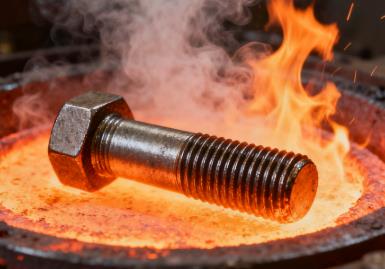In automotive engineering, bolts and screws — ranging from just a few millimeters to several centimeters in diameter — are often described as the “mechanical joints” of the vehicle. A conventional internal combustion engine (ICE) vehicle typically requires 500–800 types of fasteners, amounting to over 1,500 individual components. In comparison, new energy vehicles (NEVs) require more than 30% additional fasteners due to battery packs, electric motors, and structural reinforcements.
Though small in size, these fasteners carry the critical responsibility of connecting chassis structures, securing the powertrain, and assembling interior systems. Their performance directly determines vehicle safety, reliability, and service life. This article provides a systematic and SEO-oriented knowledge framework covering the classification, structure, manufacturing, challenges, and future innovations of automotive bolts and screws.
1. Foundational Understanding: Definition and Core Differences
Although both bolts and screws belong to the family of threaded fasteners, they differ significantly in design, working principle, and application scenarios. Distinguishing between them is fundamental to correct engineering selection.
Bolt Structure and Function
A bolt is a cylindrical fastener with an external thread designed to work with a nut. It typically consists of:
- Head: usually hexagonal or circular, providing the tool engagement point.
- Shank: the smooth cylindrical portion that bears shear loads.
- Threaded section: precision-machined threads for nut engagement, transmitting clamping force.
- Chamfered or tapered end (optional): assists in alignment during assembly.
Bolts rely on nut engagement to generate clamping force, making them suitable for removable, high-load connections. In automotive applications, bolts are commonly used for structural load-bearing joints, such as chassis cross members, suspension control arms, and engine mountings.
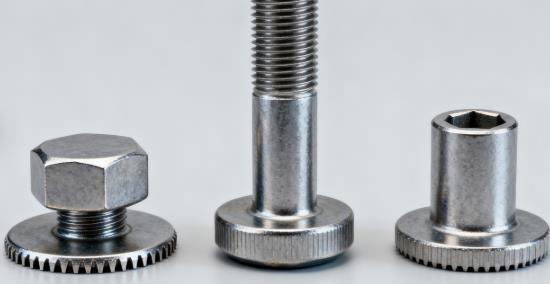
Screw Structure and Function
A screw is designed for direct fastening into materials without requiring a nut. Its structure includes:
- Head: often slotted (Phillips, Torx, hex socket) for tool engagement.
- Shank: partially or fully threaded.
- Thread: engages directly with the substrate material (metal, plastic, composites).
- Tip: pointed or self-tapping, guiding insertion.
Screws are primarily used for non-load-bearing or lightweight assemblies, such as interior trim panels, plastic dashboards, and wire harness clamps. Some self-tapping screws can cut or form threads directly in the base material, eliminating pre-tapping.
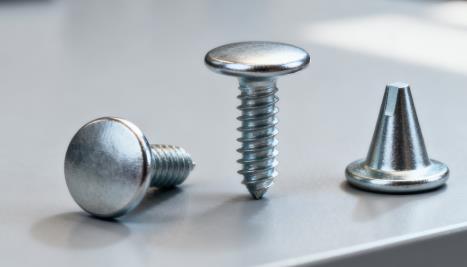
Core Differences Between Bolts and Screws
| Attribute | Bolt (with nut) | Screw (direct fastening) |
|---|---|---|
| Fastening Method | Requires nut engagement | Directly penetrates base material |
| Load Capacity | Medium to high (≥ Grade 8.8) | Low to medium (≤ Grade 5.8) |
| Disassembly | Good repeatability | Threads easily damaged after multiple removals |
| Typical Applications | Engine block, chassis suspension | Interior panels, lightweight components |
2. Comprehensive Classification of Automotive Fasteners
Automotive fasteners are classified based on functional purpose, design characteristics, and material properties. Each classification addresses performance, assembly, and cost considerations.
2.1 Functional Classification
Structural Load-Bearing Fasteners
- Function: Connect chassis, suspension, and body frames under dynamic loads, vibration, and impact.
- Materials: High-strength steels or titanium alloys.
- Grades: Typically ≥ 8.8; heavy-duty vehicles may use 12.9-grade bolts with tensile strength ≥ 1200 MPa.
General Fastening Fasteners
- Function: Non-structural assembly, such as trim panels, dashboard modules, and harness brackets.
- Grades: 3.6–5.8; emphasis on cost-effectiveness and ease of installation.
Special-Purpose Fasteners
- Examples:
- Heat-resistant bolts for exhaust systems (withstanding >600°C).
- Explosion-proof bolts for EV battery packs.
- Corrosion-resistant bolts tested for >1000-hour salt spray cycles.
- Materials: High-temperature alloys, titanium, or advanced coatings (e.g., Dacromet coating).

2.2 Design-Based Classification
Head Shapes:
- Hexagonal head (dominant in automotive fasteners, ~60% usage).
- Flange head (integrated washer for soft materials like aluminum panels).
- Socket head (Allen bolts for confined spaces such as transmissions).
- Flat head (flush finish for aesthetic interior fastening).
Special Designs:
- U-bolts for leaf spring and axle fastening.
- Carriage bolts with square shoulders preventing rotation during tightening.
- Self-tapping screws for sheet metal assembly without pre-drilling.
2.3 Material-Based Classification
Carbon Steel / Alloy Steel:
- Most common; e.g., 45# steel (Grade 8.8 after quenching and tempering).
- SCM435 alloy steel for Grade 10.9 bolts in high-strength zones.
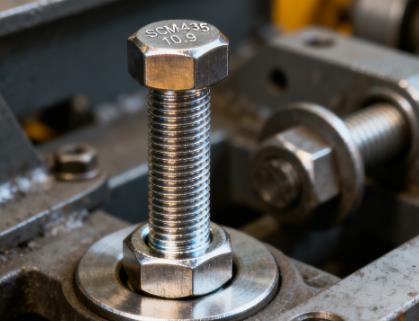
Stainless Steel:
- Type 304 for corrosion resistance (door hinges, exposed areas).
- Type 316 for marine environments (50% improved salt resistance).
Lightweight Alloys:
- Aluminum bolts (⅓ density of steel, widely used in EVs).
- Titanium fasteners (similar strength to steel but 40% lighter; critical in racing and EV battery packs).
Special Materials:
- Fiber-reinforced plastics (non-load-bearing, lightweight, electrically insulating).
- Shape-memory alloys (smart fasteners for adaptive clamping).
3. Manufacturing Process: From Raw Material to Finished Fastener
Automotive fasteners demand precision manufacturing that integrates materials science and advanced processing technologies.
3.1 Core Manufacturing Workflow
Raw Material Preparation
- Steel wire rods or alloy bars inspected, derusted, and lubricated.
- Strict chemical composition control (e.g., carbon steel 0.2–0.45% carbon).
Forming
- Cold heading (cold forging): ~90% of fasteners. Provides ≤0.02 mm dimensional tolerance, 95% material utilization.
- Hot forging: Used for bolts >24 mm diameter at 800–1200°C.
Thread Rolling
- Produces continuous grain flow, improving shear strength by ~20% compared to cutting.
- Accuracy: ≤0.01 mm pitch error.
Heat Treatment
- Quenching + tempering to achieve desired strength.
- Example: Grade 8.8 bolts quenched at 850°C and tempered at 400°C.
- Grade 12.9 bolts: tensile strength ≥1080 MPa, requiring precise cooling rates.
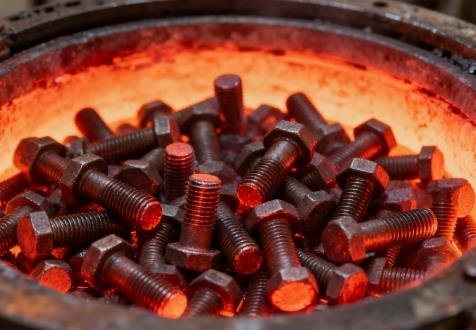
Surface Treatment
- Zinc plating: standard anti-corrosion.
- Dacromet coating: 5× corrosion resistance vs. zinc.
- Electrophoretic coating: high-temperature resistance for engine fasteners.
Quality Inspection
- Tensile, hardness, and salt spray tests.
- Microscopic analysis of grain structure.
- Automated defect detection systems achieve >99% accuracy.
3.2 Key Manufacturing Challenges
Corrosion vs. Strength Trade-Off
- Stainless steel offers corrosion resistance but lower strength than alloy steel. Hybrid coatings help balance both.
Material Compatibility
- Steel bolts with aluminum parts risk galvanic corrosion; insulating washers are required.
- High-strength bolts in plastic assemblies risk cracking unless torque is tightly controlled.
Tightening Precision
- Only 10–15% of torque is converted into useful clamping force.
- Torque-plus-angle tightening improves clamping force consistency by ~60%.
4. Ensuring Reliability: Anti-Loosening and Quality Control
Automotive fasteners must resist loosening caused by vibration, thermal cycling, and dynamic loads.
4.1 Anti-Loosening Technologies
Mechanical Methods:
- Spring washers, serrated lock washers.
- Helical inserts for thread reinforcement.
Structural Methods:
- Nylon insert lock nuts.
- Asymmetric thread profiles increasing resistance by ~30%.
Smart Anti-Loosening:
- Bolts with embedded sensors and shape-memory alloy rings.
- Detect abnormal vibrations and auto-tighten within 0.1 seconds.
- Integrated with in-vehicle networks for predictive maintenance.
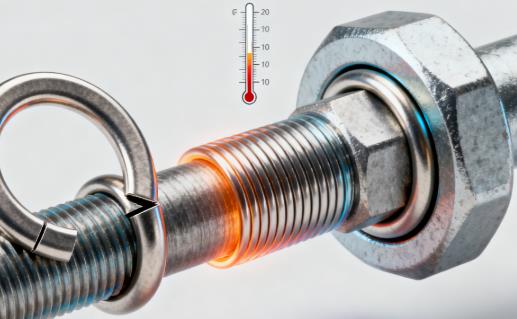
4.2 Quality Assurance Across the Chain
In-Process Monitoring:
- Cold forging monitored via real-time pressure sensors.
- Smart AGVs ensure consistent logistics between production stages.
Final Testing:
- Tensile, hardness, and corrosion resistance testing.
- Grade 12.9 bolts subjected to proof load testing to ensure safety margins.
Assembly Verification:
- Torque wrenches with digital recording integrated into MES systems.
- Full traceability across the fastener lifecycle.
5. Technological Innovations: Lightweighting and Intelligence
As the auto industry shifts toward electrification and intelligence, fastener technology evolves in three main directions.
5.1 Lightweight Materials
- Titanium fasteners in high-end EVs increased from 5% to 15% usage.
- A battery pack with titanium bolts reduced vehicle mass by 12 kg.
- Aluminum-scandium alloys double strength compared to conventional aluminum, suitable for lightweight chassis bolts.
5.2 Advanced Corrosion Protection
- Eco-friendly coatings replacing heavy-metal plating.
- Dacromet: >1000-hour salt spray protection.
- Graphene-based coatings improve corrosion resistance by an additional 40%.
5.3 Smart Fasteners
- Sensor-embedded bolts measuring stress, temperature, and vibration.
- Early warning systems for autonomous vehicles when bolt loads exceed thresholds.
- Wireless power eliminates sensor battery constraints, working reliably from -40°C to 120°C.
6. Selection Principles and Industry Outlook
Selecting the right fastener requires a three-dimensional evaluation: operating conditions, performance requirements, and cost efficiency.
- Load-based selection: e.g., 10.9-grade bolts for cylinder heads.
- Environment-based selection: 316 stainless steel for coastal vehicles.
- Assembly-based selection: socket-head screws for confined areas.
Industry Outlook
- High-strength cold forging: Mass production of >42 mm bolts with 98% material utilization.
- Integrated smart fasteners: Real-time monitoring connected to IoT platforms.
- Eco-materials: Biodegradable plastics for lightweight, environmentally friendly NEVs.
Conclusion
Although small, automotive bolts and screws are vital to the safety, performance, and reliability of vehicles. From precision cold forging with sub-millimeter tolerances to sensor-embedded smart bolts capable of real-time monitoring, these “mechanical joints” illustrate the technological depth of modern automotive engineering.
The future of automotive fasteners lies in the convergence of strength, lightweight design, corrosion resistance, and smart monitoring, ensuring they remain indispensable in supporting the next generation of electric and intelligent vehicles.
